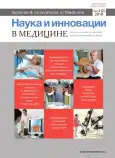Nonblinded study of immersive virtual reality efficacy for motor rehabilitation in patients with acute ischemic stroke: results presented
- Authors: Zakharov A.V.1, Khivintseva E.V.1, Kolsanov A.V.1, Poverennova I.E.1, Pyatin V.F.1, Chaplygin S.S.1, Kalinin V.A.1
-
Affiliations:
- Samara State Medical University
- Issue: Vol 4, No 2 (2019)
- Pages: 38-42
- Section: Diseases of the nervous system
- URL: https://ogarev-online.ru/2500-1388/article/view/43757
- DOI: https://doi.org/10.35693/2500-1388-2019-4-2-38-42
- ID: 43757
Cite item
Full Text
Abstract
Objectives – to evaluate the efficacy of the immersive virtual reality (VR) as a supplementary method of the motor function restoration in the lower extremities of the patients with acute ischemic stroke in the carotid territory. Berg balance scale dynamics was used for patients assessment.
Material and methods. The study included 33 patients with acute ischemic stroke in the carotid territory. The patients were randomized into two groups: the control group received the conventional treatment; the experimental group additionally received VR therapy with a sensory impact. The VR therapy included 10 sessions of 15 minutes duration each.
Results. On the 6th day of VR treatment, the static-locomotor function index on Berg balance scale was significantly improved in patients in the experimental group (p=0.03). On the last day of rehabilitation, the difference between the study groups in the static- locomotor function demonstrated the improvement on 23 points (95% CI 13–27 points) in the experimental group, the Berg balance scale improvement reached 7 points (95% CI 2–13 points).
Conclusion. The study revealed the positive input of the immersive VR sessions in static-locomotor function rehabilitation in patients in the acute period of ischemic stroke. The method demonstrated its safety and acceptability in this category of patients. Deeper immersion through the use of an explicit interaction with the VR objects could increase the efficiency of this rehabilitation method in static-locomotor function restoration.
Full Text
##article.viewOnOriginalSite##About the authors
Alexander V. Zakharov
Samara State Medical University
Author for correspondence.
Email: zakharov1977@mail.ru
ORCID iD: 0000-0003-1709-6195
PhD, Associate Professor of Department of neurology and neurosurgery
Russian Federation, SamaraElena V. Khivintseva
Samara State Medical University
Email: zakharov1977@mail.ru
ORCID iD: 0000-0002-1878-7951
PhD, Associate Professor, Department of neurology and neurosurgery
Russian Federation, SamaraAleksandr V. Kolsanov
Samara State Medical University
Email: zakharov1977@mail.ru
ORCID iD: 0000-0002-4144-7090
ResearcherId: IDB-6050-2018
PhD, Professor, Head of the Department of Operative Surgery and Clinical Anatomy with a course of innovative technologies
Russian Federation, SamaraIrina E. Poverennova
Samara State Medical University
Email: zakharov1977@mail.ru
ORCID iD: 0000-0002-2594-461X
PhD, Professor, Head of the Department of neurology and neurosurgery
Russian Federation, SamaraVasiliy F. Pyatin
Samara State Medical University
Email: zakharov1977@mail.ru
ORCID iD: 0000-0001-8777-3097
Scopus Author ID: 6507227084
PhD, Professor, Head of the Department of Physiology with the course of health and safety
Russian Federation, SamaraSergei S. Chaplygin
Samara State Medical University
Email: zakharov1977@mail.ru
ORCID iD: 0000-0002-9027-6670
PhD, Associate Professor of the Department of Operative Surgery and Clinical Anatomy with a course of innovative technologies
Russian Federation, SamaraVladimir A. Kalinin
Samara State Medical University
Email: zakharov1977@mail.ru
ORCID iD: 0000-0003-3233-8324
Scopus Author ID: 34872360600
PhD, Professor of Department of neurology and neurosurgery
Russian Federation, SamaraReferences
- Roger VL, et al. Heart disease and stroke statistics-2011 update: a report from the American Heart Association. Circulation. 2011;123(4):18–209. doi: 10.1161/CIR.0b013e31823ac046
- Feigin VL, et al. Worldwide stroke incidence and early case fatality reported in 56 population-based studies: a systematic review. Lancet Neurology. 2009;8(4):355–69. doi: 10.1016/S1474-4422(09)70025-0
- Lozano R, Naghavi M, Foreman K, et al. Global and regional mortality from 235 causes of death for 20 age groups in 1990 and 2010: a systematic analysis for the Global Burden of Disease Study 2010. Lancet. 2012;380(9859):2095–2128. doi: 10.1016/S0140-6736(12)61728-0
- Wang W, et al. Prevalence, incidence, and mortality of stroke in China: results from a nationwide population-based survey of 480 687 adults. Circulation. 2017;135(8):759–71. doi: 10.1161/CIRCULATIONAHA.116.025250
- Prabhakaran S, et al. Inter-individual variability in the capacity for motor recovery after ischemic stroke. Neurorehabilitation and Neural Repair. 2008;22(1):64–71. doi: 10.1177/1545968307305302
- Batchelor FA, Mackintosh SF, Said CM, Hill KD. Falls after stroke. Int J Stroke. 2012;7(6):482–490. doi: 10.1111/j.1747-4949.2012.00796.x
- Rodrigues-Baroni JM, Nascimento LR, Ada L, Teixeira-Salmela LF. Walking training associated with virtual reality-based training increases walking speed of individuals with chronic stroke: systematic review with meta-analysis. Brazilian Journal of Physical Therapy. 2014;18(6):502–512. doi: 10.1590/bjpt-rbf.2014.0062
- Gonzalez RG, Hirisch JA, Koroshetz WJ, et al. Acute ischemic stroke: imaging and intervention R.G. Gonzalez, Berlin–Heidelberg–New York: Springer, 2006. doi: 10.1007/978-3-642-12751-9
- Richards CL, Malouin F, Nadeau S. Stroke rehabilitation: clinical picture, assessment, and therapeutic challenge. Progress in Brain Research. 2015;218:253–80. doi: 10.1016/bs.pbr.2015.01.003
- Saposnik G, et al. Efficacy and safety of non-immersive virtual reality exercising in stroke rehabilitation (EVREST): a randomised, multicentre, single-blind, controlled trial. Lancet Neurology. 2016;15(10):1019–27. doi: 10.1016/S1474-4422(16)30121-1
- Teasell R, et al. Stroke rehabilitation: an international perspective. Top Stroke Rehabililitation. 2009;16(1):44–56. doi: 10.1310/tsr1601-44
- Laver KE, et al. Realidad virtual para la rehabilitación delaccidente cerebrovascular. John Wiley & Sons Ltd for the Cochrane Collaboration, 2011. doi: 10.1002/14651858
- Martín BP, et al. Aplicación de la realidad virtual en los aspectosmotores de la neurorrehabilitación. Reviews Neurology. 2010;51:481–8. doi: 10.33588/rn.5108.2009665
- Park D, et al. Effects of virtual reality training using Xbox Kinect on motor function in stroke survivors: a preliminary study. Journal of Stroke and Cerebrovascular Diseases. 2017;2313–19. doi: 10.1016/ j.jstrokecerebrovasdis.2017.05.019
- Lee S, Kim Y, Lee BH. Effect of virtual reality-based bilateral upper extremity training on upper extremity function after stroke: a randomized controlled clinical trial. Occupational Therapy International. 2016;23(4):357–68. doi: 10.1002/oti.1437
Supplementary files








